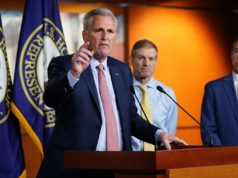If there’s a lesson to be learned from the frustration and anger observed across the political spectrum, it’s that too many Americans have borne the brunt of rapid and dramatic economic disruption — changes stemming from technological progress, trade agreements, globalization, and shifts in government policy — without seeing any upside. Their real concerns make it critical that we offer new solutions to empower communities, companies, and workers to succeed in a changing economic landscape, with a special focus on these “economic adjustment” programs for Americans who are most affected by profound economic changes.
That’s why, last week, Sen. Shelley Moore Capito Shelley Moore CapitoEconomic adjustment strategies for the 21st Century Coal-country advocates push aid for jobless miners ‘Nuclear’ cloud looms over Trump agenda MORE (R-W.Va.) and I sent a letter calling on the Government Accountability Office (GAO) to review current federal government economic adjustment programs and identify options for a more comprehensive policy response. As an independent, nonpartisan agency, GAO is responsible for investigating how Congress spends taxpayer dollars. We believe that a review by GAO of the current programs is a necessary first step to understanding the parameters of a more effective economic agenda.
Shelley Moore CapitoEconomic adjustment strategies for the 21st Century Coal-country advocates push aid for jobless miners ‘Nuclear’ cloud looms over Trump agenda MORE (R-W.Va.) and I sent a letter calling on the Government Accountability Office (GAO) to review current federal government economic adjustment programs and identify options for a more comprehensive policy response. As an independent, nonpartisan agency, GAO is responsible for investigating how Congress spends taxpayer dollars. We believe that a review by GAO of the current programs is a necessary first step to understanding the parameters of a more effective economic agenda.
ADVERTISEMENT
To date, lawmakers of both parties have sought to address the impacts of economic challenges with discrete economic adjustment programs focused on the causes of the disruption. Here’s a quick overview of those programs.
To address and mitigate the impacts of trade-related actions, Congress created a program known as Trade Adjustment Assistance (TAA) for workers run by the Department of Labor (DOL). For businesses affected by global trade, there is a separate program (TAA for Firms) operated by the Economic Development Administration (EDA). If the source of the economic pain is determined to be changes in defense spending (such as base closings or defunded weapons systems), the Defense Department’s Office of Economic Adjustment addresses impacts that result from these changes with what’s known as a Defense Industry Adjustment program.
Most recently, an initiative known as POWER (Partnerships for Opportunity and Workforce and Economic Revitalization), a joint effort led by the Appalachian Regional Commission and EDA, assists those impacted by changes in energy policy, especially coal mines and coal-fired power plants.
These programs offer widely varying levels and types of benefits to regions, companies, and affected workers. For the most part they are reactive — making benefits available only after plants have closed or workers have lost their jobs, once beneficiaries have been certified as eligible. These programs aren’t open to those who work in a sector or company impacted more generally by industry-changing technologies like robotics, or by disruptive business models like autonomous vehicles. More importantly, when federal programs engage with workers only after the impacts of dramatic change have taken root, options available for mitigating the effects are severely limited.
In addition to programs with an explicit mission to address economic disruptions, other agency programs sometimes provide technical assistance and resources as well. These include the National Institute of Standards and Technology’s Manufacturing Extension Partnership program, EDA’s Economic Adjustment Program, DOL programs created by the Workforce Innovation and Opportunities Act, and others.
Taken as a whole, the U.S. investment in prevention, mitigation, and transition is insufficient. The Economist found that most countries with an economy similar to ours spend six times as much as the United States on job retraining and other economic adjustment programs. Between the patchwork nature and lack of investment, it’s no surprise that Americans are finding these programs painfully inadequate.
That’s why we’re advocating for a broad new approach to economic adjustment programs in the United States. That approach would encompass several key principles missing today, including:
- Serve “at-risk” regions, firms and workers without regard to the cause of the economic challenge;
- Simplify determination of eligibility to promote faster access to streamlined services;
- Provide services proactively to maximize opportunities for averting layoffs, helping companies diversify into new products and markets, and mitigating impacts;
- Engage fully the range of business assistance and support services available through existing programs; and,
- Provide robust benefits and services to those for whom diversification and mitigation efforts are not successful.
Dramatic changes in the global economy demand that Republicans and Democrats think differently about how to mitigate the effects of those changes and position the U.S. to succeed in the future. The American people deserve better, and our economic future depends on it.
Read our full letter to the Government Accountability Office here.
The views expressed by this author are their own and are not the views of The Hill.







